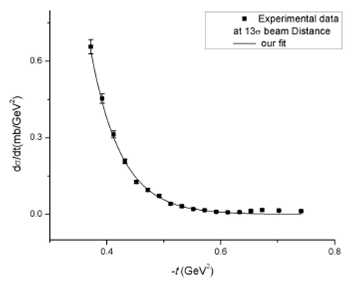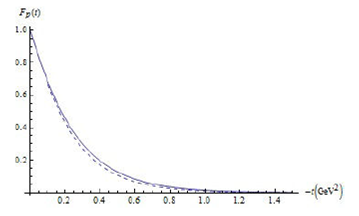1.Introduction
The structure of particles can be probed with the help of scattering experiments. The high energy scattering processes are now approachable present us with an opportunity to examine the hadronic structure at higher energies 1-9. Among hadrons, the proton structure has remained a topic of interest between researchers since its discovery. Proton’s radius is a prime problem in the study of its structure. The root-mean-square (rms) radius of a proton can be experimentally measured by two methods; electron proton scattering 10 and atomic spectroscopy technique. In hydrogen spectroscopy, two methods are adopted: one by using atomic hydrogen 11 and a second by using muonic hydrogen 12; both of these methods give contradictory results, giving rise to the so-called “proton radius puzzle”. There are many theoretical approaches to find out the rms radius of proton, including MIT Bag model 13, self-consistent model 14, by using Lattice QCD 15-17, etc.
The form factor also plays a dynamic role in the study of hadronic structure. It is
related to the distribution of matter inside a hadron. Theories claiming to explain
the structure of hadrons must be able to calculate their form factors from first
principles. Continuous efforts of decades led the researchers to obtain the form
factors of proton from different calculation schemes, as discussed in 18-22. Experimentally, the magnitude of the form factor
is determined by the ratio of the measured cross-section to the Mott cross-section:
In this work, proton-proton elastic scattering data from TOTEM experiment 9 is used to calculate the proton
form factor employing the simplest version of Chou-Yang model. The Chou-Yang model
23,24 is a geometrical model. In this
model two hadrons are considered to be scattering elastically and are supposed to be
translucent objects passing through each other without attenuation. The differential
cross section (
Hadron’s radius is associated to the form factor by the relation
(for details see Ref. 25). This
relation is very useful for finding out the form factor of scattering hadrons. Many
form factors of proton were suggested by researchers at lower values of
2.Calculations
In this work recent data of elastic proton-proton scatteringat

Figure 1 Fitting of differential cross section data of protonproton elastic
scattering at

Figure 2 Fitting of differential cross section data of protonproton elastic
scattering at
The most appropriate values of
Table I Fitted parameters for two set of data, i.e., for 13 σBeam and 4.3 σBeam distance
| j |
α j (mb−1/GeV / c ) |
β j (GeV )-2 | Adj. R-squared for fit |
| 1 | 683.06 ± 228.29 | −18.75 ± 0.76886 | 0.96907 |
| 2 | 375.62 ±4.09935 | -17.15±0.0806 | 0.99914 |
The measure of goodness of fit is determined by R-square, given in Table 1. Which shows that our fit is 100% successful in both set of data. These values of α and β are used in Eq. (2) directly, and a computer program is used to solve this equation for finite values of n. The square of form factors of proton is found to be equal to
Here j = 1 and 2 for differential cross section data at 13 σBeam and 4.3
σBeam distance respectively.
Table II Computed values of a ji and b ji .
| For 13 σBeam distance j=1 | For 4.3 σBeam distance j=2 | |||
| i | aij | bij | aij | bij |
| 1 | 2:898290 | -18:75452 | -1:742644 | -17:1527 |
| 2 | 14.74531 | -9:37726 | 10.93454 | 10.93454 |
Using electromagnetic form factor from (3) we can easily compute rms charge radius of
proton by using following relation
3.Discussion
The Chou Yang model is successful in its predictions for elastic scattering process
at higher as well as the lower values of
and











 nueva página del texto (beta)
nueva página del texto (beta)




